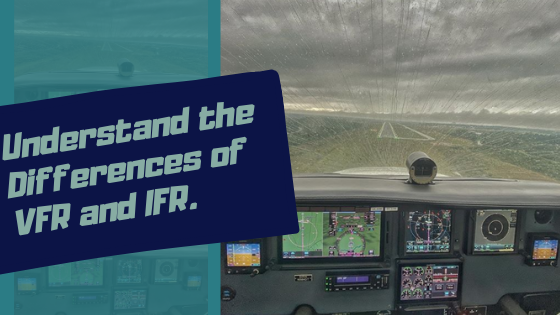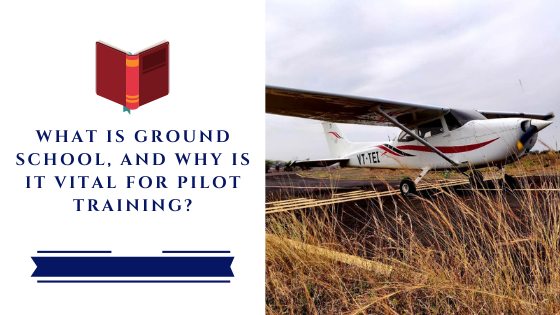IFR vs. VFR

This post will remove your confusion on the acronyms VFR vs. IFR. As a student pilot beginning your pilot training, you may doubt what kind of flight activity you will take. Is it VFR or IFR?
As a student pilot, you will learn to operate an airplane in VFR.
- So what are the differences between VFR and IFR?
- Why can’t pilots fly IFR from the beginning?
VFR and IFR are two set of rules determined by the FAA for airplane operations. A pilot must conduct flights following either of the set rules.
Pilots can’t choose which set of rules to use for flying as they wish.
Sounds confusing, right?
As the pilot in command of an aircraft, you will decide when to take off and where to fly. However, the weather will impact your decision on which set of rules to pick for flying on any particular day.
- On a windy day with thunderstorms, you cannot fly VFR no matter how urgently you need to go somewhere.
- If you don’t know how to operate an IFR plane, you can cancel your flight for that day.
- To ensure safety during adverse weather conditions, you need to fly following IFR.
To understand IFR vs. VFR elaborately, continue reading.
What is VFR?
VFR means Visual Flight Rules. Operating an airplane in VFR means the pilot of the aircraft has excellent visibility outside the plane. The pilot has a clear view of the ground from the flight.
Thus, the pilot is navigating the airplane with visual references outside the aircraft.
Likewise, the pilot is staying out of the clouds and bad weather, possibly bad weather en-route.
Such an excellent condition for flying is known as VMC, Visual meteorological condition.
So what are the VFR minimums?
There are some set conditions by FAA for conducting a VFR flight. If one intends to fly VFR, then they must consider this:
- Visibility in the departure airports vicinity should be more than 5 statute miles.
- The ceiling of the cloud in the area should be 3000 feet.
When I say in the vicinity of the departure airport, I meant the conditions are applicable within five nautical miles radius of the airport.
If within the five nautical miles radius of the airport, the ceiling is lower than 3000 feet, then you will not be allowed to fly VFR because the condition is below minimum.
This kind of condition in an airport is always depicted on the aeronautical chart using the color green.
How to recognize the VFR variations?
MVFR – Marginal Visual Flight Rules.
Once the weather is slightly below the VFR minimums in the vicinity of your departure airport, the tower may grant your request for flying MVFR.
Regardless it is always better not to fly in MVFR conditions. Because of three reasons:
- The weather may get worse once you takeoff;
- You don’t know how the weather might be en-route;
- Risking your flight’s safety is not wise flying MVFR if you don’t have an instrument rating.
What are the MVFR minimums?
MVFR weather condition is slightly better than IFR flying conditions.
You can request to fly VFR in MVFR condition, meaning:
- The ceiling of the cloud is between 1000 feet to 3000 feet;
- The visibility must be between 3 statute miles to 5 statute miles.
These conditions are set by the FAA for ATC to grant VFR flight in MVFR.
Typically, in this condition, if a pilot request for takeoff, the tower may ask you what your intentions are to take off in this adverse weather.
As a pilot, if you have an urgency to go somewhere and have no alternative option, then the twoer will grant your takeoff request.
Nevertheless, it is wiser to get an instrument rating before flying in condition below VFR minimums.
MVFR condition is depicted on aeronautical charts using color Blue.
MVFR is an advisory term that refers to weather conditions better than Instrument Meteorological Conditions but lower than Visual Meteorological Conditions.
What are the responsibility of a pilot operating a VFR flight?
Flight VFR means a pilot is navigating the airplane relying on outside references.
The outside references are mostly on the surface, and a pilot flying at 2500 feet above ground level (AGL) in Visual Meteorological conditions can see the surface.
During a VFR flight, the pilot is responsible for staying away from the clouds and preventing traffic collisions. Likewise, Flight navigation is solely the pilot’s responsibility.
The pilot doesn’t have to follow a designated flight path suggested by the air traffic controller once you are clear of the airspace.
Thus in VFR flight, the pilot has to communicate to be aware of any airspace traffic.
What is IFR?
IFR stands for instrument flight rules. When the weather is adverse and visibility is low, the condition is called Instrument meteorological condition (IMC).
According to IFR, pilots don’t have permission to fly VFR and file a flight plan in such weather. If you intend to depart from an airport with low visibility, you must be an IFR-rated pilot.
An IFR rated pilot can conduct a safe flight solely relying on the instrument and without any visual reference outside the aircraft or on the surface.
Unlike a VFR pilot, an IFR pilot has the privilege of flying in Instrument meteorological condition (IMC).
The FAA sets instrument flight rules:
- The pilot needs to be IFR rated; and
- The aircraft must have IFR instruments to fly safely in and out of airspaces.
It may sound scary to think of flying without any visual reference outside. Hence, a pilot acquires instrument rating is like leveling up their flying skills and becoming a more competent pilot.
All airlines operate their flight merely using the aircraft’s instruments unless it is indispensable to fly using visual flight rules.
Airlines operate many flights at night and in adverse weather conditions, meaning they must operate those flights according to Instrument flight rules.
What are the IFR minimums?
There are conditions set by the FAA to consider when an airport is IFR.
Weather condition on the surface and within five nautical miles of the airport has to meet these conditions:
- Visibility must be between 1 to 3 statute miles;
- The cloud ceiling must be between 500 to 1000 feet.
You can certainly understand why it is impossible to operate an airplane using visual references outside.
The visibility is low, and the cloud ceiling is below 1000 feet.
Conduct a VFR flight even at 2500 feet in such a condition is risky. Hence, one must know how to maneuver and use navigation instruments to complete a flight leg without looking outside.
IFR condition in an airspace is depicted on charts using color Red.
What are the IFR variations?
The only IFR variation is LIFR, and flying in such conditions can be challenging for even most expert IFR pilots.
What is LIFR?
LIFR stands for Low Instrument Flight Rules. An airport states LIFR if the meteorological condition in the airport surface is poor and deteriorating.
Usually, when an airport has advised LIFR, the cloud coverage ceiling in the area is shallow. LIFR conditions states that the airport surface has:
- Visibility is less than one statute mile;
- The ceiling of the cloud is less than 500 feet.
In this condition, operating an airplane with no instrument rating is out of the question. If a pilot approaches the LIFR airport, the pilot won’t see the runway until they are very close to the runway.
Perhaps the pilot will notice the runway while he is at 200 feet.
Therefore, in LIFR, the pilot must navigate and commence approach relying on the airplane instruments and air traffic controller instructions.
The LIFR condition is depicted with color Magenta on aeronautical charts.
What are the responsibilities of IFR pilots?
IFR pilots need to file a flight plan ahead of time to keep the route free of traffic. Therefore during an IFR flight, the pilot must follow air traffic controllers’ instructed course to conduct safe flights.
As the pilot operates without knowledge of traffic in the vicinity, following ATC instruction is crucial to avoid traffic.
The pilot uses instruments to maintain altitude, direction and navigate the airplane. On the contrary, the ATC will provide information to prevent a collision course with other aircraft.
Unlike VFR flight, you have minimum visibility outside, but the ATC can see the radar images of any inbound traffic, and ATC is aware of any inbound traffic as they have the flight plans.
When to get an IFR rating?
Once a student pilot acquires his private pilot license, you can immediately start your instrument rating training.
If you meet all the instrument rating requirements, apply for your instrument rating.
How tricky is IFR vs. VFR?
VFR flying is a lot simpler if you compare it to IFR flying. You have to understand these:
- Operating a flight in zero visibility conditions requires skills and a lot more awareness of the pilot;
- The communication is longer in IFR versus VFR flights.
In VFR flight, the pilot picks his course and stays away from a collision course.
Opposingly, in an IFR flight, the pilot listens to the ATC’s instructions carefully and follow. A miscommunication between the tower and the pilot in an IFR flight is unsafe.
Thus IFR flight operation is done sincerely. In IFR training, a pilot has to study subjects in detail to ensure flights’ safety.
Therefore IFR training is complex versus VFR training. However, obtaining an instrument rating also massively contributes to VFR flying proficiency.



